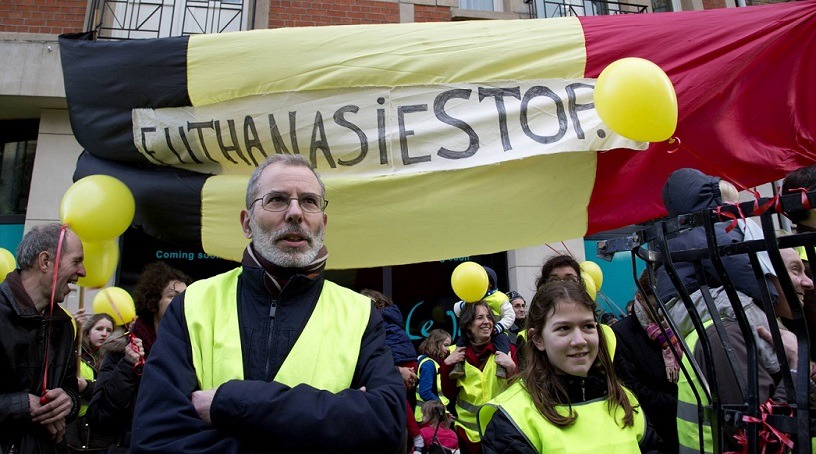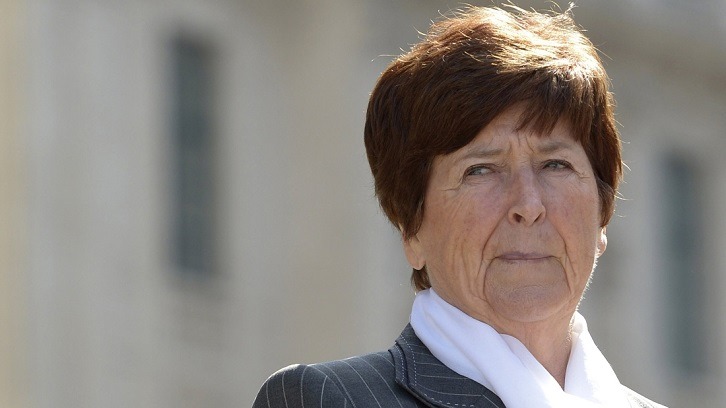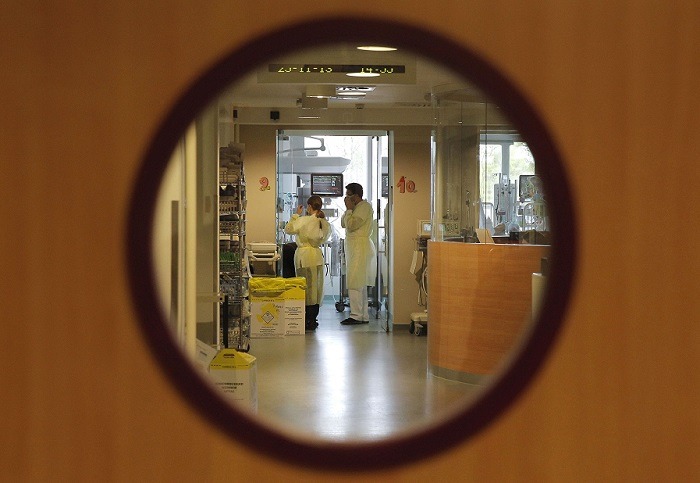The 2008 euthanization of European literary icon Hugo Claus, who was suffering from Alzheimer’s disease, spurred a debate in Flanders, where 80% of Belgium’s euthanasia requests are received. Shortly after his death, René Stockman, the Superior General of Broeders van de Liefde, a Catholic organisation with over 17,000 employees in healthcare and education, penned an article claiming that it was “nauseating” how some people tried to suggest heroism in Claus’ decision to die via euthanasia. Further critique followed from Belgium’s most prominent religious figure, Archbishop Danneels in his Easter speech.
Euthanasia advocate Dr. Wim Distelmans of the VUB, reacted strongly. He has since come to head Belgium’s Federal Euthanasia Commission. Ten years on and the issue has shifted dramatically. Euthanasia and assisted suicide are now legal in a handful of countries, and more normalised in Belgium. But the transition has been far from smooth and new issues are arising with the increased prevalence of euthanasia cases. Lost behind the moral-absolutist din of anti-euthanasia campaigns is a trickle of legitimate bioethical concern and serious questions are starting to be raised about Belgium’s euthanasia laws.
The opposition and controversy
In 2002, Belgium became the second country in the world to legalise Euthanasia. It has since been made legal for patients suffering from psychological ailments, as well as for minors, though minors may not request euthanasia for psychological reasons.
In concrete terms this means that: “At the request of the patient, a doctor may apply euthanasia if all conditions laid down in the law are met. This request is expressed by a legally competent patient who is conscious or by a prior consent.”
Those conditions demand – among other things – that the physical or psychological suffering of the patient be incurable, that the patient requests to be euthanised is of their own initiative and made in a state of mental clarity and that the request be handled by at least two medical professionals.
On the one hand, a loosely organised group of campaigners, generally linked with religious organisations, are continuing to express vociferous opposition to euthanasia at large. Sometimes apparently objective articles will make unsourced, unsubstantiated claims. One heavily cited article published by the catholic news agency cynically tried to link the Nazi “euthanasia” programme, whereby handicapped individuals were euthanised without consent, with contemporary euthanasia programs, despite the fact that there is nothing in common between the two.

Catholic groups have been vocal in their opposition to euthanasia.
The objections are moral in nature, and though their coverage may ostensibly point to seemingly faulty mechanisms in the euthanasia infrastructure, it is fairly clear that they oppose euthanasia all together. This vocal opposition has created a low rumble of interference that has sensationalised recent cases of alleged malpractice in the world of palliative care in Belgium and abroad.
With euthanasia for both terminally ill and non-terminally ill patients increasing in frequency in Belgium and the Netherlands, there is more than enough fodder for campaigners. These sensationalised occurrences evoke deeply emotional responses in the minds of readers, and the moral pandering obfuscates some of the legitimate bioethical questions.
Stories of botched sexual reassignment surgery leading to euthanasia, or doctors being emotionally distant and hands off with requests pose serious moral dilemmas, but advocates of euthanasia say that they were undertaken in a procedurally sound way. They argue that these cases are sensational precisely because they are extreme in nature. The last available statistics from the Belgian government (2014-2015) would agree with that assessment, with only 0.2% of the 2,022 euthanasia procedures requiring further proof to determine if they were correctly executed medically.
The vast majority of requests, around 84% are for people above the age of 60 (no minors were euthanised during that same time period). Around 97% of euthanasia procedures were for non psychological ailments, meaning that the patients were terminally ill and suffering incurable pain. Of those that were euthanised for psychological reasons, only about one-third of them had their applications approved.
Support in the public eye remains strong
The anti-euthanasia campaign has not had the desired effect. Public support for euthanasia is still very high, and the number of people opting to ease their own death medically is increasing year on year. Proponents are unabashed in their support, and public figures from government ministers to para-athletes are openly declaring that they have opted for euthanasia when the time comes. There was even substantial public backlash against a religious healthcare provider who refused to allow a 74 year old patient suffering from terminal lung cancer to be euthanised. The vulgarity of prolonging someone’s suffering against their wishes was not lost on the general public.

Miet Smet is a Belgian politician serving as a member of the Flemish Parliament for the Christian Democrat and Flemish party. She recently made headlines following her open announcement, confirming she had filled in the necessary paperwork to become euthanised. In an interview, she explained that having seen her husband suffer, she decided that “I want to die with dignity. If I get worse, I’ll choose euthanasia. The paperwork is ready and signed”.
The backlash against this case forced Broeders van Liefde to officially comply with euthanasia laws in Belgium. In March of 2017, the Catholic health care organisation released a mission statement on euthanasia outlining their beliefs. They centred their argument on three fundamental pillars: the sanctity of life, patient autonomy and the relationship between carer and patient. The decision was taken by a board of directors that is majority not religiously affiliated. In response, the aforementioned brother René Stockman brought a complaint against his own organisation to the Vatican, who have since given them an ultimatum.
The importance of debate and improvements to the law
What is being obscured by the zealous attempts to “end” the practice are the legitimate calls for reflection on the state of euthanasia as an institution. Last year, Ariane Bazan, ULB psychology professor and member of the mental health advocacy think tank, Kollectief Zonder Dwang, elaborated in an interview why she was advocating for a complete scrapping of euthanasia for psychological reasons. The general argument being that a lack of public understanding about mental health and the curability of mental illness leading patients to first consider euthanasia as a treatment option is ethically dubious. A psychiatrist simply cannot know, she claims.
Again, the law states that whatever illness a patient is suffering from must be incurable. Other psychiatrists have suggested that it is possible that some people have been euthanised despite there having been other treatment options.
This type of argumentation moves the issue away from the moral and into the ethical. Oftentimes, one of the doctors signing off on a euthanasia request is a family practitioner. Is it ethically correct for a doctor who likely hasn’t attended any mental health training in decades to be one of the doctors signing off on such a request? There have been instances where patients were euthanised due to psychological suffering, and the time elapsed between first consultation and execution is only a month, leaving family members demanding answers.
While Wim Distelman recently spoke out, and even distanced his medical practice from that of psychiatrist Lieve Thienpont, who was profiled in a Washington Post article in 2017 for being very lax in her granting of euthanasia requests, he has been unabashed in his support of other questionable cases.
The most troubling of which revolve around the resignation of self proclaimed “euthanasia supporter” Ludo Vanopdenbosch from the Federal Euthanasia Commission (FEC). Dr. Vanopdenbosch, who has his own palliative care practice, tendered his resignation after feeling silenced at the monthly FEC meeting in September, when raising objections to the euthanisation of a patient suffering from dementia and Parkinson’s who had never specifically asked to be euthanised.
Reports suggest that family members asked doctors to euthanise the patient, and that they had not once asked for the procedure themselves. A doctor even had to dictate what needed to be written in the application. After hours of debate, the FEC waved off suggestions that it should be sent for review to a prosecutor’s office. To date, not a single case has.
When confronted, Dr. Distelmans claimed that it was mislabeled by the doctor as euthanasia when it should have been called palliative sedation. But palliative sedation is not intended to kill, only to alleviate symptoms of suffering. On top of that, it took more than a month to get the approval to perform the euthanisation, which would mean that the doctor did not provide palliative sedation for that whole time, presumably leaving their patient to suffer. Any way you cut it, it is a pretty clear-cut violation of ethics.
According to Dr. Vanopdenbosch, the patient was not even capable of requesting euthanasia. It has led many experts in the field to suggest that the FEC has too much oversight over its own activities, and that they have lost the plot. Despite the FEC having to answer directly to the Belgian parliament on a yearly basis been requested clarifications on a number of occasions.
While cases such as these shed light on the possible failings of patient protection, they remain only a fraction of the total procedures executed. Euthanasia continues to ease the suffering of thousands of patients every year and spares them the indignity of a discrete, illegal suicide, or a drawn-out painful death.
A petition to restrict euthanasia is currently going around, and bears the signatures of both professionals and moral crusaders, once again conflating the issue. The effectiveness of this petition may be limited, but renewed public interest, as well as inaction and dismissiveness on behalf of the FEC could encourage a healthy and productive euthanasia debate in the near future.
By Alexandre D'hoore


